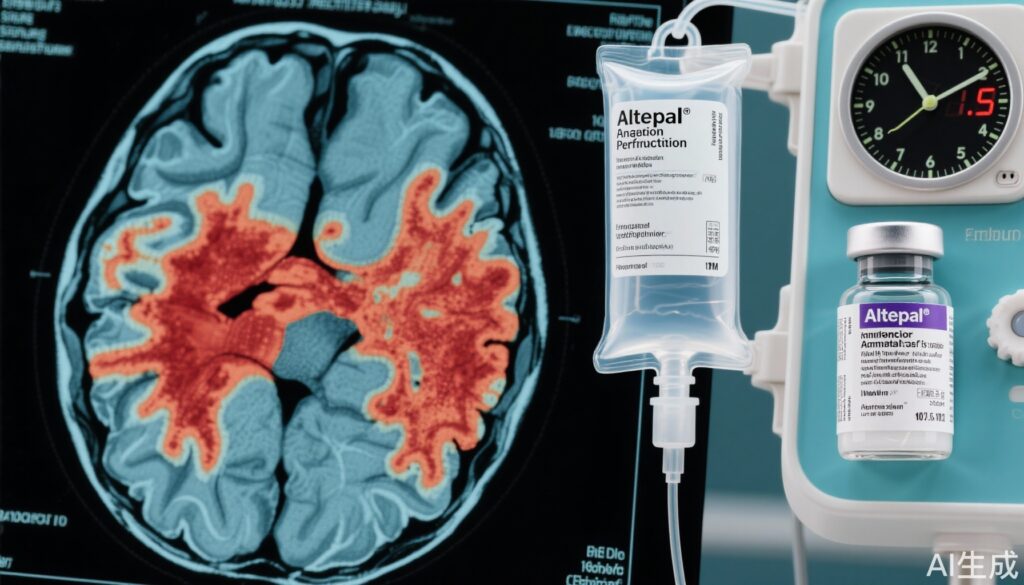Highlight
– Intravenous alteplase administered 4.5 to 24 hours after ischemic stroke onset improves functional independence in selected patients.
– The benefit extends to patients identified with salvageable brain tissue via perfusion imaging, irrespective of large vessel occlusion status.
– Alteplase use beyond 4.5 hours increases the risk of symptomatic intracranial hemorrhage but does not increase overall mortality.
Study Background and Disease Burden
Acute ischemic stroke (AIS) remains a leading cause of morbidity and mortality worldwide. Rapid revascularization to restore cerebral blood flow is critical for limiting irreversible brain damage. Intravenous thrombolysis with alteplase is approved as an effective reperfusion treatment when administered within 4.5 hours of stroke onset. However, many patients present beyond this conventional therapeutic window, limiting access to thrombolytic therapy. While endovascular thrombectomy extends treatment opportunities for certain patients with large vessel occlusion, it is not applicable or initially planned for all AIS patients.
Perfusion imaging techniques enable identification of salvageable brain tissue beyond traditional time frames by distinguishing penumbral regions at risk but not yet infarcted. Prior studies have confirmed the benefit of mechanical thrombectomy and thrombolysis based on imaging selection in extended windows, but data on intravenous alteplase beyond 4.5 hours and up to 24 hours remain sparse and understudied. This unmet need prompted the HOPE trial, designed to evaluate the efficacy and safety of intravenous alteplase in a prolonged window post-stroke for patients with salvageable brain tissue identified by advanced imaging.
Study Design
The HOPE trial is a randomized, open-label, blinded endpoint study conducted at 26 stroke centers across China from June 2021 through June 2024 with follow-up completed by October 2024.
Eligible participants included 372 adult patients with acute ischemic stroke presenting between 4.5 and 24 hours after symptom onset or the midpoint between last known well and recognition when onset was unknown. All patients demonstrated salvageable brain tissue on perfusion imaging and were not scheduled for initial endovascular thrombectomy.
Participants were randomized in a 1:1 ratio to receive either intravenous alteplase at 0.9 mg/kg (maximum 90 mg) or standard medical treatment without thrombolysis. Randomization employed a minimization algorithm to balance baseline characteristics. The primary efficacy endpoint was functional independence at 90 days, defined as a modified Rankin Scale score of 0 to 1. Safety endpoints included symptomatic intracranial hemorrhage within 36 hours and all-cause mortality at 90 days.
Key Findings
Among the enrolled cohort, the median age was 72 years (interquartile range 64–80), with 43% women. All randomized patients completed the trial protocol and follow-up.
Functional independence was achieved in 40% (75/186) of the alteplase group compared to 26% (49/186) in the control group. This corresponded to a statistically significant adjusted risk ratio of 1.52 (95% CI, 1.14–2.02; P = .004). The absolute risk difference was 13.98% (95% CI, 4.50%–23.45%). These data indicate a clinically meaningful improvement in favorable functional outcomes with alteplase administered well beyond the traditional 4.5-hour window.
Regarding safety, symptomatic intracranial hemorrhage occurred more frequently in the alteplase group at 3.8% versus 0.51% in controls. The adjusted risk ratio was 7.34 (95% CI, 1.54–34.84; P = .01), with an absolute risk difference of 3.23% (95% CI, 0.28%–6.19%). Despite this increased risk of hemorrhagic complications, mortality at 90 days was equivalent between groups (11% in both; adjusted risk ratio 0.91, 95% CI 0.52–1.62; P = .76).
These findings support the use of alteplase in a carefully selected subgroup of patients with ischemic stroke and salvageable brain tissue, even when treatment is started up to 24 hours after stroke onset.
Expert Commentary
The HOPE trial addresses a critical gap in stroke care by extending the established therapeutic window for intravenous thrombolysis. Identification of salvageable brain tissue via perfusion imaging represents a paradigm shift from rigid time-based treatment decisions to tissue-based approaches, optimizing patient selection and outcomes.
While endovascular thrombectomy has extended the treatment horizon for large vessel occlusions, many stroke patients without such occlusions, or those ineligible for thrombectomy, previously lacked options beyond 4.5 hours. HOPE’s demonstration of benefit with alteplase in this population may influence future guideline revisions and clinical practice.
However, the increased risk of symptomatic intracranial hemorrhage highlights the need for meticulous patient selection, weighing benefits against risks, and emphasizes the importance of advanced imaging to confirm salvageable penumbra. Additional research is warranted to define optimal patient profiles and further refine risk mitigation strategies.
The open-label design and single-country trial setting should be considered when interpreting generalizability. Nevertheless, these promising results align with prior studies such as EXTEND and WAKE-UP that supported the efficacy of thrombolysis beyond conventional time windows guided by imaging.
Conclusion
The HOPE randomized clinical trial provides robust evidence that intravenous alteplase administered between 4.5 and 24 hours after ischemic stroke onset improves functional outcomes in patients selected with perfusion imaging to have salvageable brain tissue and no initial plan for thrombectomy. While the treatment increases symptomatic intracranial hemorrhage risk, it does not adversely impact 90-day mortality.
This advancement supports a refined, tissue-based approach to thrombolysis, potentially expanding treatment access and improving recovery for a broader ischemic stroke population. Integration of perfusion imaging into routine evaluation and individualized risk assessment is essential for safe and effective implementation. Future studies should continue to optimize treatment windows, imaging criteria, and combined reperfusion strategies to enhance outcomes further.
References
1. Zhou Y, He Y, Campbell BCV, et al. Alteplase for Acute Ischemic Stroke at 4.5 to 24 Hours: The HOPE Randomized Clinical Trial. JAMA. 2025;334(9):788-797. doi:10.1001/jama.2025.12063.
2. Ma H, Campbell BC, Parsons MW, et al. Thrombolysis guided by perfusion imaging up to 9 hours after stroke onset (EXTEND): a randomized controlled trial. Lancet. 2019;393(10175): 1727-1736.
3. Thomalla G, Simonsen CZ, Boutitie F, et al. MRI-guided thrombolysis for stroke with unknown time of onset. N Engl J Med. 2018;379(7):611-622.
4. Powers WJ, Rabinstein AA, Ackerson T, et al. Guidelines for the early management of patients with acute ischemic stroke: 2019 update. Stroke. 2019;50(12):e344-e418.



